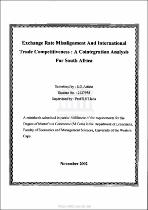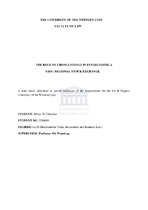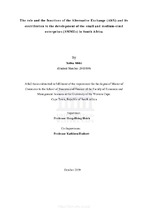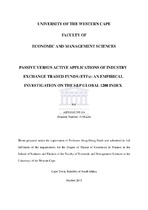| dc.contributor.advisor | Huda, S.N | |
| dc.contributor.author | Asfaha, S.G. | |
| dc.date.accessioned | 2021-02-08T08:48:43Z | |
| dc.date.available | 2021-02-08T08:48:43Z | |
| dc.date.issued | 2002 | |
| dc.identifier.uri | http://hdl.handle.net/11394/7772 | |
| dc.description | Magister Commercii - MCom | en_US |
| dc.description.abstract | Issues pertaining to the misalignment of exchange rate have become central in the analysis of open economy macroeconomics for developing countries. This is at least due to two reasons: first persistent overvaluation of currency is seen as a powerful early warning of potential currency crisis and second protracted periods of exchange rate misalignment are highly associated with poor economic performance in a number of developing countries. Owing to this fact, economists are in concession that aligning real exchange rates towards their equilibrium values is an important component of macroeconomic policy adjustments in order to achieve and maintain a sustainable development. For this purpose the estimation of the degree of the real exchange rate misalignment has become pivotal. However, despite the concession among economists regarding the need to minimize the frequency and magnitude of exchange rate misalignment, the estimation of the equilibrium exchange rate (hence the misalignment) has been among the most controversial and challenging issues in modem macroeconomics. For several decades, the Purchasing power parity (PPP) approach-which is based on the law of one price-has been the most widely used methodology for the estimation of the equilibrium exchange rate in both developed and developing countries. In South Africa some attempts have been made to estimate the misalignment of the rand against major currencies on the basis of the PPP approach. However, large numbers of empirical studies show that PPP does not hold except in the 'ultra' long run. In addition, PPP's assumption of a constant equilibrium exchange rate makes it ill-fitted to serve as a bench-mark for the analysis of the exchange rate in countries such as South Africa that experience substantial structural changes. As a result a number of macro-econometric models underlying on the macroeconomic
determinants of exchange rate have been developed, albeit with little applicability in developing countries. In this study, we have used Edwards' (1989) intertemporal general equilibrium model of a small open economy in order to estimate the degree of the real exchange rate misalignment and its impact on the international trade competitiveness of the South African economy for the period 1985:1-2000:4. For this purpose a dynamic single equation error correction model of a first order autoregressive distributed lag model, ADL (1,1), and five years moving average technique have been employed to estimate the exchange rate misalignment. Whereas impulse response analysis and variance decomposition techniques of a cointegrated VAR (vector auto regression) have been established to assess the impact of the misalignment on trade competitiveness. The fmdings of the study reveal that the real exchange rate had been consistently overvalued during the period' 1988:3-1998:2 but undervalued during periods 1998:3- 2000:4. For most of the periods during 1985:1-1988:2 the rand had been undervalued. More over the study discloses that exchange rate misalignment debilitates South Africa's international trade competitiveness accounting for 20 percent of the variation in competitiveness. | en_US |
| dc.language.iso | en | en_US |
| dc.publisher | University of the Western Cape | en_US |
| dc.subject | Exchange rate misalignment | en_US |
| dc.subject | International trade competitiveness | en_US |
| dc.subject | Equilibrium exchange rate | en_US |
| dc.subject | Edwards' exchange rate model | en_US |
| dc.subject | Internal balance | en_US |
| dc.subject | External balance | en_US |
| dc.subject | Exchange rate fundamentals | en_US |
| dc.subject | Cointegration analysis | en_US |
| dc.subject | Tradables | en_US |
| dc.subject | Nontradables | en_US |
| dc.title | Exchange rate misalignment and international trade competitiveness : A cointegration analysis for South Africa | en_US |
| dc.rights.holder | University of the Western Cape | en_US |




